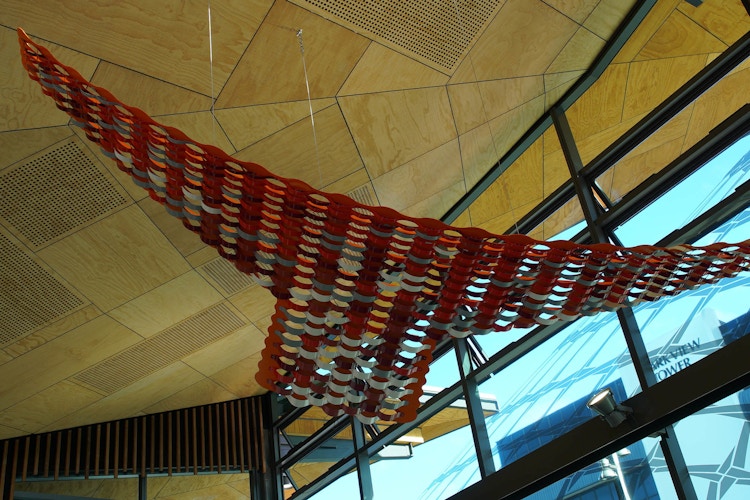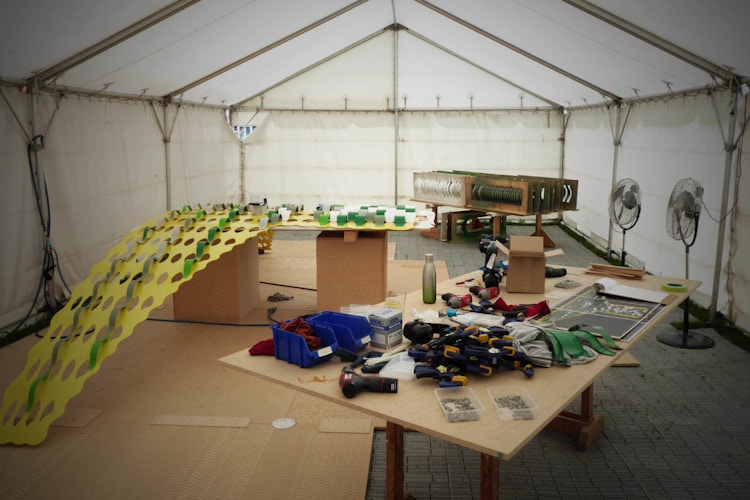Ngā Matukurua
- Location
- Manukau
- Client
- Auckland Regional Transport
- Architect
- Beca & Cox Davies
Auckland Regional Transport (ART) approached our design studio to create artworks for the award-winning Manakau Bus Terminal in Auckland. As part of a focus on development centred around honouring Mana Whenua various artists and groups were engaged. Initially, we put together a concept proposal for the artwork within the whole building. Later as the project developed we were asked by Te Akitai, who were one of three local iwi being represented, to be their representative artist. We sat with the iwi in their marae and listened to their stories.
The Story
There is one common ancestor from the 17th century: Hua-kai-waka (“eater of canoes”) of the Waiohua iwi. When Hua-kai-waka lay on his deathbed he asked for a calabash of water for one last drink. As he finished he dropped the calabash and it smashed, scattering many droplets of water. These droplets became the waka which carried the descendants of Hua-kai-waka. Two Waiohua chiefs were brothers descended from Hua-kai-waka. Their wives argued. They agreed to settle the dispute with a manu (kite) flying competition. The second son’s kite flew higher but the first son cut the string and his brother had to travel a long way to retrieve it. These two brothers lived in fortified pā on the two maunga of south Auckland in the area called Wiri. One lived in Matukutūreia which means the careless bittern. He was not vigilant, often going tuna fishing or sleeping, so when warriors came he was defeated. The other lived in the pā called Matukutūruru which means the watchful bittern, ever alert like the morepork owl, te ruru.
A theme of Transportation
In early Maori times the highways were waterways. Today buses and roads echo this history. The Manukau bus hub could have been a canoe hub. We proposed that these common stories form the narrative expressed by design in the building. The two blocks of buildings, one at each end are the two maunga, and the calabash of Huakaiwaka is in the centre where the tickets are dispersed.
The Result
Our artworks are the two kites flown by the brothers, one at each end. Through our own design aesthetic we reinterpreted these kite forms to be a more woven cloak-like surface. We presented these proposals first to Te Akitai, then to several mana whenua meetings, and they were accepted, though not everyone agreed on the exact story.During the collaboration process, the kites went through a series of iterations balancing practical/engineering requirements with cultural/aesthetic ones. The kites are made from powder-coated aluminium. The patterns and colours represent the weaving of tukutuku panels, as well as the patterns of bird feathers.
Thanks to
Te Akitai iwi (Mere and Nigel Denny), and Mana Whenua, as well as input from ART (Ian Kingston, Lawrence Wong and Anthony Williams). The architects Beca (Steve Gray and Nick McLean).
https://www.stuff.co.nz/auckland/local-news/manukau-courier/103735921/lovely-light-manukau-bus-station-wins-praise-in-architecture-awards

Auckland Regional Transport (ART) approached our design studio to create artworks for the award-winning Manakau Bus Terminal in Auckland. As part of a focus on development centred around honouring Mana Whenua various artists and groups were engaged. Initially, we put together a concept proposal for the artwork within the whole building. Later as the project developed we were asked by Te Akitai, who were one of three local iwi being represented, to be their representative artist. We sat with the iwi in their marae and listened to their stories.
The Story
There is one common ancestor from the 17th century: Hua-kai-waka (“eater of canoes”) of the Waiohua iwi. When Hua-kai-waka lay on his deathbed he asked for a calabash of water for one last drink. As he finished he dropped the calabash and it smashed, scattering many droplets of water. These droplets became the waka which carried the descendants of Hua-kai-waka. Two Waiohua chiefs were brothers descended from Hua-kai-waka. Their wives argued. They agreed to settle the dispute with a manu (kite) flying competition. The second son’s kite flew higher but the first son cut the string and his brother had to travel a long way to retrieve it. These two brothers lived in fortified pā on the two maunga of south Auckland in the area called Wiri. One lived in Matukutūreia which means the careless bittern. He was not vigilant, often going tuna fishing or sleeping, so when warriors came he was defeated. The other lived in the pā called Matukutūruru which means the watchful bittern, ever alert like the morepork owl, te ruru.
A theme of Transportation
In early Maori times the highways were waterways. Today buses and roads echo this history. The Manukau bus hub could have been a canoe hub. We proposed that these common stories form the narrative expressed by design in the building. The two blocks of buildings, one at each end are the two maunga, and the calabash of Huakaiwaka is in the centre where the tickets are dispersed.
The Result
Our artworks are the two kites flown by the brothers, one at each end. Through our own design aesthetic we reinterpreted these kite forms to be a more woven cloak-like surface. We presented these proposals first to Te Akitai, then to several mana whenua meetings, and they were accepted, though not everyone agreed on the exact story.During the collaboration process, the kites went through a series of iterations balancing practical/engineering requirements with cultural/aesthetic ones. The kites are made from powder-coated aluminium. The patterns and colours represent the weaving of tukutuku panels, as well as the patterns of bird feathers.
Thanks to
Te Akitai iwi (Mere and Nigel Denny), and Mana Whenua, as well as input from ART (Ian Kingston, Lawrence Wong and Anthony Williams). The architects Beca (Steve Gray and Nick McLean).
https://www.stuff.co.nz/auckland/local-news/manukau-courier/103735921/lovely-light-manukau-bus-station-wins-praise-in-architecture-awards








